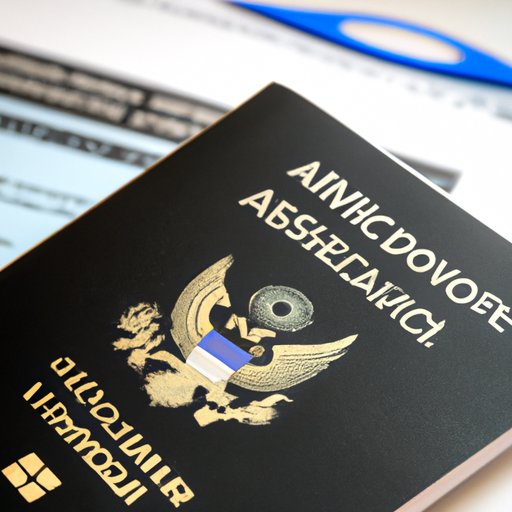
Introduction
Domestic air travel in the United States can be confusing and intimidating. With changing regulations and strict security measures, it can be difficult to know exactly what documentation and identification is required to board your flight. This article aims to provide a comprehensive guide to the documentation and identification needed for domestic air travel in the US, as well as the legal requirements and common mistakes to avoid.
Checklist for Domestic Air Travel in the US: Identification, Documents, and Requirements
When traveling domestically within the US, certain documents and identification are required to board your flight. To avoid any confusion and potential delays during travel, it is important to make sure you have the following documentation on hand:
- Valid government-issued photo ID: This can include a passport, driver’s license, or state-issued ID card. Make sure your ID is not expired and matches the name on your boarding pass. Non-US citizens should also carry their passport and any necessary visa or residency documents.
- Boarding pass: This is typically obtained when checking in for your flight, either through the airline’s website or at the airport kiosk or counter.
- Travel itinerary: This includes any confirmation numbers, flight details, and hotel reservations you may need during your trip.
In addition to the above items, there may be specific requirements for different types of travelers. For example, minors traveling alone may need additional documentation, such as a notarized permission letter from a parent or guardian. Non-US citizens may also need additional visa or residency documentation. For travelers with disabilities, it is recommended to notify the airline ahead of time and request any necessary accommodations.
The Essentials of Flying in the United States: What You Need to Know Before You Board
Before you board your flight, there are a few key things to keep in mind to make the travel experience as smooth as possible.
- Check-in times: Most airlines recommend arriving at least two hours before domestic flights and three hours before international flights. This allows time for any security screenings and potential delays.
- Baggage limits: Make sure to check your airline’s baggage policy before arriving at the airport. Most airlines allow for one carry-on bag and one personal item, such as a purse or laptop bag. Checked baggage may also have size and weight limitations.
- Security procedures: Before entering the airport, make sure to remove any liquids or electronics from your carry-on bag and follow the TSA’s 3-1-1 rule: 3.4 ounces or less per container, placed in a quart-sized plastic bag, and one bag per passenger. Wear easily removable shoes and outerwear to speed up the security process.
Being prepared and following these guidelines can help ensure a stress-free travel experience.
Flying in the US: A Guide to the Documentation and Identification You Need
While valid government-issued ID is the most important document needed for domestic air travel in the US, there may be some confusion around common mistakes and misconceptions. For example, a driver’s license from one US state may not be valid in another state, and TSA PreCheck does not exempt you from needing proper identification.
Other forms of identification that may be accepted include a passport card, Global Entry card, or Trusted Traveler Program card. It’s important to double-check with your airline beforehand to confirm which forms of ID are accepted.
Preparing for Takeoff: Legal Requirements and Necessary Documentation for Domestic US Flights
When traveling domestically in the US, there are a few legal requirements to keep in mind. The TSA has strict security measures in place, including a ban on certain items and liquids in carry-on bags. It is recommended to familiarize yourself with these restrictions before arriving at the airport to avoid any confusion or delays.
In addition to TSA regulations, many states have specific ID requirements for domestic air travel. As of 2021, the Real ID Act requires all US residents to have a Real ID-compliant driver’s license or alternate form of ID to board domestic flights. Travelers can check their state’s DMV website to see if their current ID is Real ID-compliant or if they need to apply for a new ID.
Essential Travel Documents and Identification You Must Have to Board a Flight in the US
When preparing to travel domestically in the US, it’s important to have the following essential documents and identification:
- Valid government-issued photo ID
- Boarding pass
- Travel itinerary
- Real ID-compliant driver’s license or alternate form of ID (if applicable)
In addition, it is recommended to keep all documents and identification together in a secure, easily accessible location, such as a designated travel wallet or pouch.
Domestic Flight Travel: A Comprehensive Guide to the Documents and Identification Required in the US
When traveling domestically in the US, there are many factors to consider in terms of documentation and identification. From government-issued ID to boarding passes and travel itineraries, it can be overwhelming. To make sure you have everything you need for a smooth travel experience, follow this comprehensive guide:
- Make sure you have a valid government-issued photo ID that matches the name on your boarding pass.
- Check your airline’s baggage policy and any potential fees before arriving at the airport.
- Remove any liquids or electronics from your carry-on bag and follow TSA regulations.
- If applicable, make sure your ID is Real ID-compliant or apply for a new ID from your state’s DMV.
- Keep all necessary documents and identification together in a secure, accessible location during travel.
Following these guidelines can help ensure a smooth travel experience and prevent any unnecessary delays or complications.
Conclusion
Domestic air travel in the US can be stressful, especially when it comes to the necessary documentation and identification required. However, by following the tips and guidelines outlined in this article, travelers can feel confident and prepared for their journey. Remember to always double-check your documentation and identification before traveling and allow enough time for potential delays or security screenings.




